Free Shipping on orders of $49+ | Signup for Direct Rewards
Free Shipping on orders of $49+ | Free Store Pickup | Signup for Direct Rewards
Free Shipping on orders of $49+ | Signup for Direct Rewards
Free Shipping on orders of $49+ | Free Store Pickup | Signup for Direct Rewards

Did you know that there are over 440 known species of sharks around the world! Maybe you’ve heard of a few such as Hammerheads, Great Whites, and Tiger Sharks, but there are so many more and everyone of them is unique and interesting in their own way. From Goblin Sharks and Basking Sharks, to Wobbegongs and Cookiecutter Sharks, they come in all shapes and sizes. Sharks are very important for the aquatic ecosystem. They are basically like the white blood cells of the ocean. The ocean is survival of the fittest, and sharks will take out the weak, sick, and dead to help prevent disease and weak genes from spreading. By doing this, only the strongest survive through natural selection allowing evolution to happen over time.
Over the years the media has painted an image of sharks being ferocious creatures that should be avoided at all costs. However, in reality you’re more likely to be killed by a cow or even a vending machine than a shark! Sharks on average kill 5 people per year, and in many cases, these attacks are provoked by the victim. But with the proper instruction and/or training, an encounter with these beautiful creatures can be somewhat magical. There are a ton of places around the world to hop in the water with sharks. Different places will highlight specific species local to their area. Here are some of the best places to dive with sharks around the world.
Imagine Tiger Sharks as long as the water is deep! That’s what you can see at Tiger Beach in Grand Bahama. Growing up to 18ft long, you can see up to 15 sharks at once in just 20 feet of water. These giants are known around the world to be very ferocious. However, in reality they are quite gentle creatures that have no interest in eating people. Especially at Tiger Beach, many of the sharks are regulars and have even been named. Perhaps to keep nervous divers calm. After all, a 15ft Tiger can be quite scary until you find out her name is Princess. But every diver should have respect for them. They very well could eat you if they chose to. So avoid touching them and putting your body parts where they shouldn’t be.
Originally, these dive trips were done via liveaboard dive charters, but now there are a few land based charters that you can take while you visit the island.
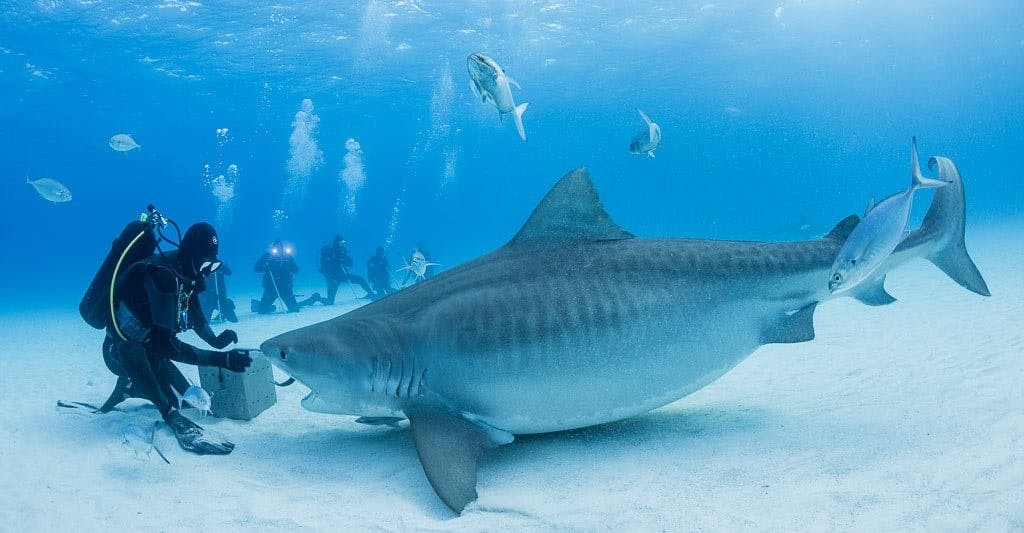
An expert feeder will set up a milk crate or bucket of fish chunks up the current creating a slick of chum to help bring the sharks into the divers view. The divers will line up in a “V” pattern so that the chum and sharks can pass right through the middle of them. This gives divers and underwater photographers a great view of these sharks and some ideas for planning their next shots. Tiger Sharks aren’t the only attraction at these dive sites though. There can also be many Lemon Sharks, Caribbean Reef Sharks, Nurse Sharks, and even Great Hammerheads that will visit the site.
When it comes to diving on large wrecks with dozens of sharks you wouldn’t think of North Carolina. But you definitely need to! North Carolina is actually known as “The Graveyard of the Atlantic” because of the large number of shipwrecks along the coast. Many of these shipwrecks such as the Caribsea and U-352 German submarine were sunk during WWII. The first 50 miles off the coast of North Carolina is pretty much a flat, barren wasteland. So these wrecks are like an oasis to an abundance of marine life.
Sand Tiger Sharks call these wrecks home year round. So you won’t need any chum or bait to draw them in because they’re already there! North Carolina is one of the rare places where you can experience an amazing wreck dive and a shark dive at the same time. Sand Tigers themselves are very docile creatures and are very tolerant of divers getting up close so long as you move slow and smoothly. For photographers looking to get some amazing shots, this is an amazing opportunity. Getting under one of these beautiful creatures and shooting their white underbellies up against the surface of the water provides a nice contrast so you can see their amazing figure.
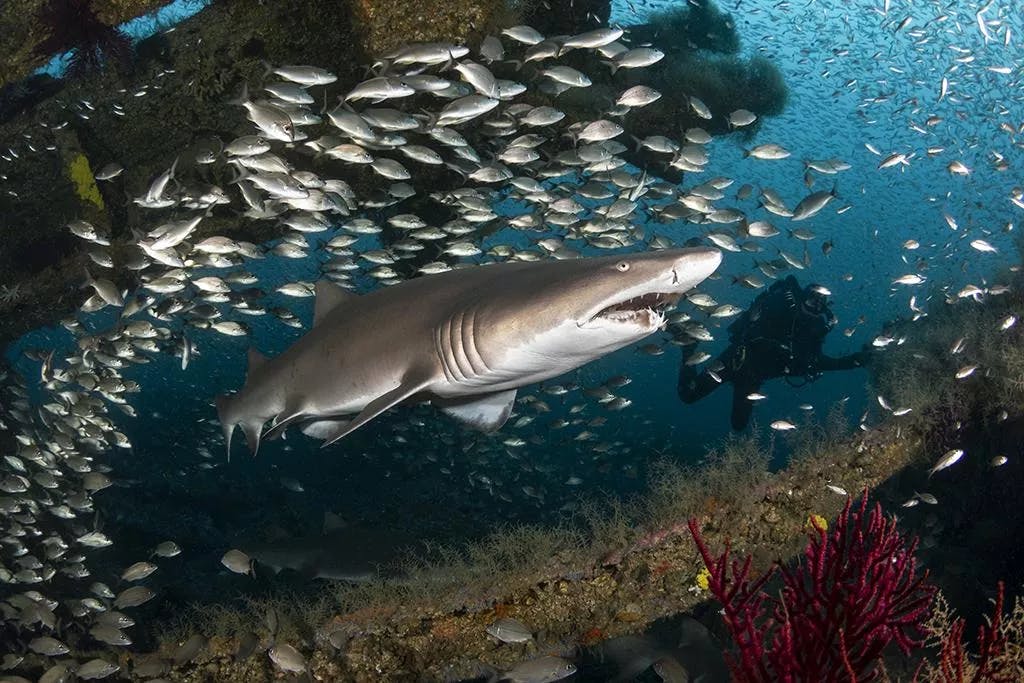
You will also notice their mouth which always remains open all the time showcasing their underbite with ragged teeth. Another cool sight to see is when the baitfish school around these sharks to hide themselves from other predators. When shooting this, make sure to use higher shutter speeds so you can get a nice sharp image.
Located 340 miles off the shore of Costa Rica is the beautiful Bajo Alcyone. Bajo Alycone is only accessible by liveaboard so be prepared to spend a couple days on the water. It can take nearly 2 days to get to this Hammerhead heaven, but once you hop in the water you’ll realize why divers consistently visit this dive site soon enough. With amazing visibility, extreme biodiversity, and hundreds of Scalloped Hammerheads this dive almost feels unreal. Diving down and looking up at these magnificent creatures looks almost like an episode on Discovery Channel. Hundreds of Scalloped Hammerheads and thousands of Bigeye Jacks fill your view as you stare in awe. Although the main attraction at this site is definitely the Hammerheads, there’s no shortage of other marine life! Other sharks that can be seen include Whitetips, Blacktips, Silvertips, and Silky Sharks. Even Manta and Mobula Rays can be seen visiting cleaning stations in the area.

As the second largest fish in the world, diving with Basking Sharks is a must add to your diving bucket list. These sharks can grow to over 33ft long with a gaping mouth that opens to over 3ft in diameter as they feed on plankton. Yes, you read that right…plankton. The second largest fish in the ocean filter feeds plankton just like the more famous Whale Shark. Basking Sharks are not aggressive and will continue on as if you’re not even there in the water with them.
Diving with these humongous creatures is actually done through snorkeling. Because these sharks are filter feeders, they will stay at the surface for the majority of time so that they can feed. But when you take a trip with Basking Shark Scotland, you can book a multi day, multi dive site trip so that you can get some diving and underwater photography in as well.
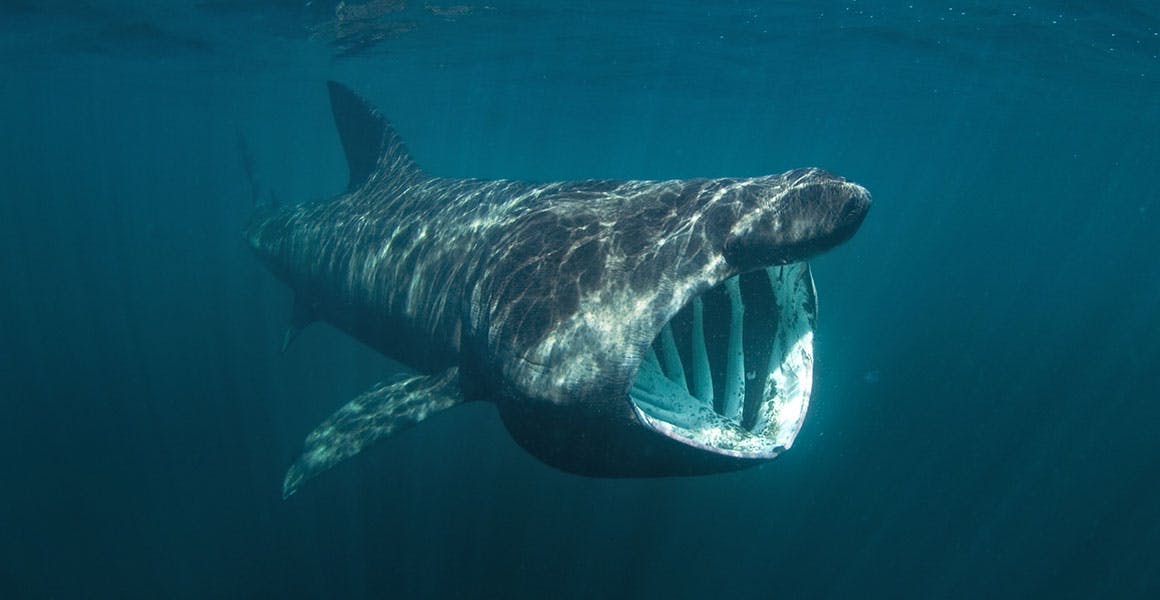
Thanks to historic trading routes, there is an abundance of wrecks covered in coral and lobster that you can dive on. Or book a Basking Shark only trip to maximize your chances of seeing these magnificent sharks.
The Monad Shoal is like one of the diving wonders of the world. The Monad Shoal itself is not too interesting, but it is the rare Thresher Sharks in the area that make this one of the top dive sites in the world. Thresher sharks are a rare sight to see for divers because they are typically roaming cooler deep waters. However, just before dawn, schools of Thresher Sharks will visit the Monad Shoal which sits in about 60ft (20m) of water for a cleaning to help them remove parasites from their skin, mouth, and gills. Being a dawn dive, you will have to be in the water around 6am! Standard lighting equipment can help reveal these wondrous creatures without causing too much of a disturbance, but ideally the sunlight can be used to spot these sharks against the surface. Some other species you can see include Cuttlefish, Lionfish, Manta Rays, Mantis Shrimp, Moray Eels, Pygmy Seahorses, Octopus and more!
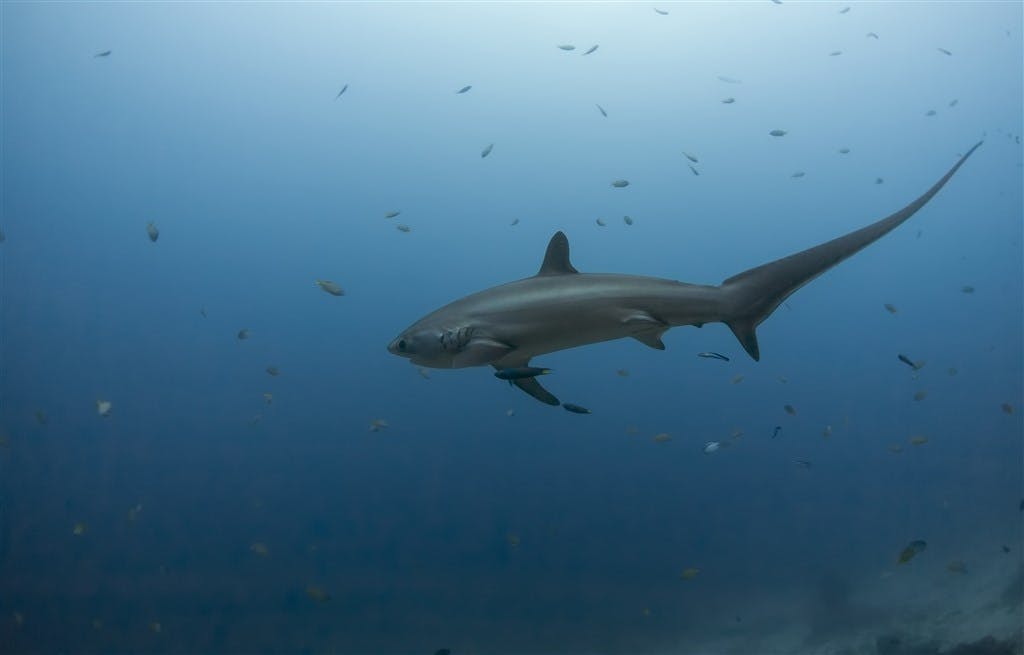
Only accessible by boat or seaplane, diving in Prince William Sound, Alaska can be quite the trip. The highlight of the trip being snorkeling with giant Salmon Sharks. Salmon Sharks look like the Great White Shark’s younger sibling, except without all the ferocious behavior. Salmon Sharks are actually known to be quite shy, so it is important to very slowly approach these creatures. And even then they can still dart away into deeper water. In most cases your charter will bait these fish to get you up close and personal with them. Salmon Sharks migrate to this sound every year to feast on spawning salmon. They will find a place to hide behind rocky structures before ambushing their prey. Most do not migrate very far away, and some can even be seen year round. After snorkeling with these massive sharks, you can dive to the bottom where you’ll find beautiful coral reefs home to many octopus and a variety of fish species. The water here can be quite chilly though! Ranging from 36℉ on cold days to 55℉ on warmer days in the spring. Make sure you bring a 7mm wetsuit or a drysuit so that you can be comfortable in the water.
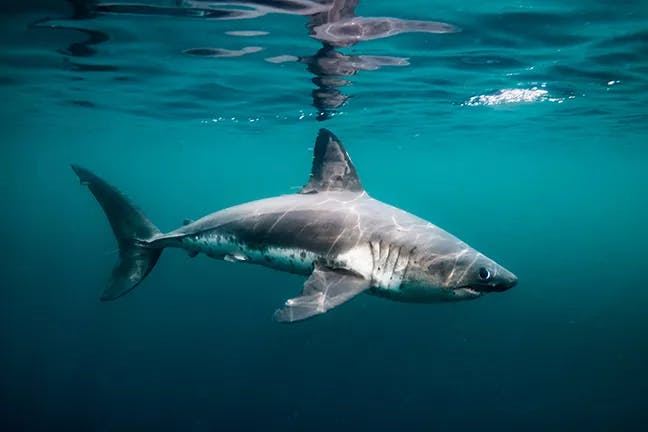
Home to at least 366 individually identified sharks and still counting, Isla Guadalupe is one of only 4 places in the world where you can dive with Great White Sharks. Diving with Nautilus Dive Adventures, you will typically see two to three great whites per trip, but in July and August, you can see as many as 47 on one trip! Isla Guadalupe is only accessible via liveaboard, so your trips will last at least a few days. Traveling to Isla Guadalupe alone can take up to 20 hours from San Diego or Ensenada, Mexico. But the Great White encounters are 100% worth it!
The bulk of diving with these enormous Great Whites are done in the safety of an underwater enclosure or cage. Freediving with Great Whites should only be done by experienced professionals. After all, Great Whites account for the most amount of shark attacks per year. Many liveaboard charters will use a hookah setup so you don’t have to carry a tank on your back giving you more freedom and maneuverability inside the cage, but some will do a traditional tank dive setup for submersible cages.
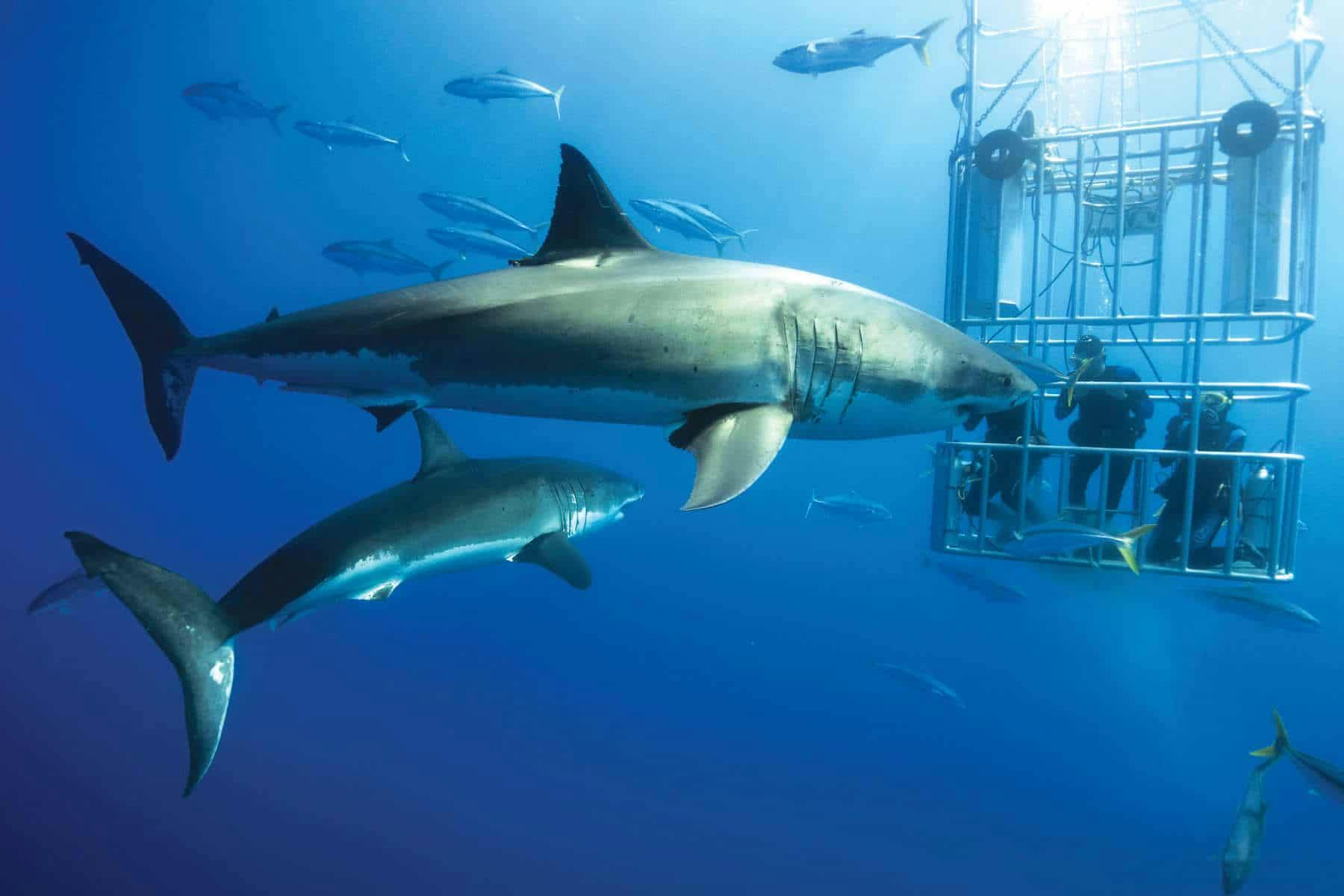
Belize is by far one of the world's top dive destinations. With the second largest barrier reef in the world, the famous Blue Hole, and the gentle giant Whale Sharks Belize has it all. And in Placencia, Belize you can experience everything Belize has to offer. Many dive charters will even take you to a combination of these famous locations in one dive trip. Gladden Spit itself features a wall that slopes down to 160ft deep and then drops off into the ocean abyss. However, when diving at this location, groups of no more than 12 divers will dive no deeper than 60ft so that they don’t disturb the Whale Sharks too much.
Every year Whale Sharks circumnavigate the globe and stop at Gladden Spit to feed during the months of March through June. During these months Gladden Spit is a popular spawning site for a variety of unique tropical fish species including Cubera and Mutton Snapper which produce a LOT of spawn. This is why Whale Sharks continue to visit Gladden Spit every year. After all, Whale Sharks can eat up to 45 lbs of plankton per day.
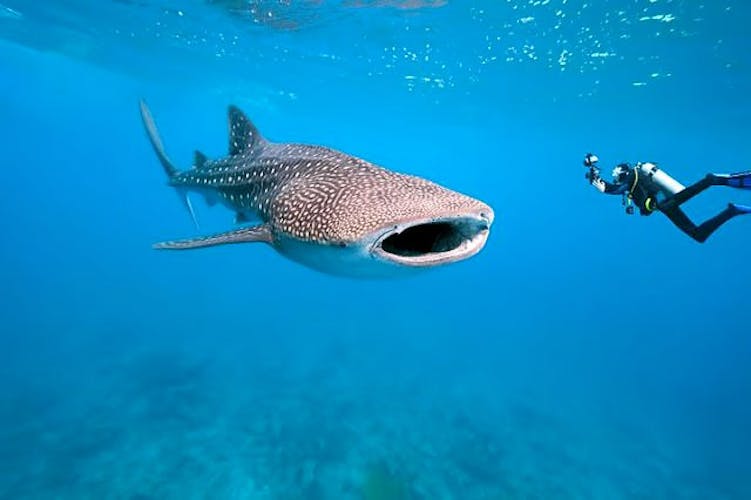
It is important for divers to understand that Whale Sharks are an endangered species and cannot be touched, grabbed, or rode while diving. Snorkelers can also enjoy this location because these Whale Sharks will come to the surface to feed. But don’t be nervous, Whale Sharks have no intention of consuming a human. They are filter feeders and only eat plankton and other small nektonic organisms.
California has one of the highest concentrations of sharks in the world, making it one of our top shark diving destinations. There are a wide variety of sharks to be seen, from Leopard Sharks to Great Whites. But we are going to focus specifically on the Blue Sharks and Mako Sharks found in deep water offshore. Divers can charter a boat to dive cageless with these fast pelagic predators. And although the media may depict these sharks as stealthy killers, they are actually some of the more docile shark species. But of course, always make sure to be wary and don’t let your guard down. Divers of all levels and even snorkelers can experience these sharks. No experience or certifications are needed, so anyone can participate, and some charters will even provide the gear you need. California Shark Diving provides a “Shark Viewing Trip” so that people who want to stay dry can still experience these beautiful creatures from the safety of the boat.

Ever seen a seven gill Cow Shark? Chances are probably not because Pyramid Rock is one of only two places in the world where you can dive with these rare sharks. Cow sharks are very unique and extremely distinguishable from other shark species. They have seven gill slits as well as only one dorsal fin towards the back of their tail. Pyramid Rock in False Bay, South Africa provides a very unique seascape to see the infamous Cow Shark. In shallow, kelp forests you can see up to 18 of these seven gill sharks at once because they are known to be social feeders. The Pyramid Rock itself can normally be seen breaking the surface unless the tide is extremely high.
Divers can access this dive from the shore or by boat, but a shore dive can be challenging for a number of reasons. The shore entry point is a small rocky beach that can be quite slippery especially when conditions are unfavorable. You can also enter from an old slipway at the Cape Boat Club, but this can be dangerous because the channel is narrow and shallow due to the kelp forests and rocks on both sides.
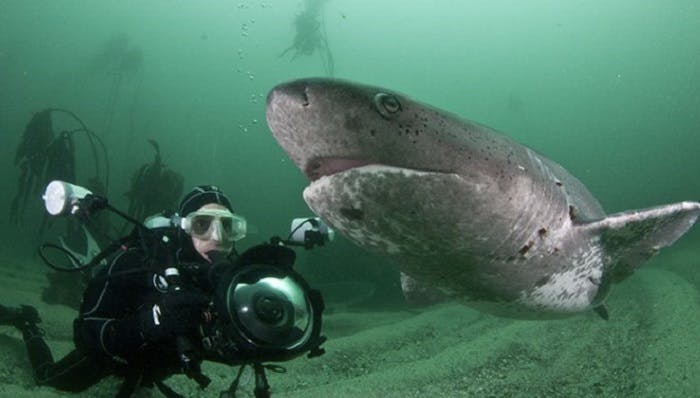
There are many routes you can choose to take. There are no good anchor points for boats though, so be sure to have a plan and be cautious of other boaters navigating the channels. The marine life on this dive is very unique. You’ll not only see rare Cow Sharks, but you can also see Roman Seabream, Pyjama Shark, Red Steenbras, Cape Knifejaw, and more! Visibility averages around 10m, so be wary of your surroundings and be mindful when doing photography. The Cow Sharks will often approach close to divers, so a wide angle lens can be useful.
When life gives you lemons, you take out your camera and snap a pic. Lemon Sharks are one the most common shark species in Jupiter, Florida. They have a uniquely tinted yellow color that distinguishes them from other shark species. But these aren’t the only sharks you can see in Jupiter. You can also see Silky Sharks, Dusky Sharks, Caribbean Reef Sharks, Nurse Sharks, Hammerhead Sharks, Bull Sharks, and even Tiger Sharks! Some are more rare than others and are typically only seen during their migration patterns, but some are seen year round. These sharks are wild creatures, but any time you take a shark diving charter, you are almost guaranteed to see some amazing sharks. Certain dive charters like Florida Shark Diving will take everyone out to see these magnificent creatures. From freedivers, to avid divers they are prepared with gear and experts to provide you with the best experience possible. They also provide a Shark Viewing Trip so that guests who want to watch the sharks without getting in the water can enjoy a spectacular show.
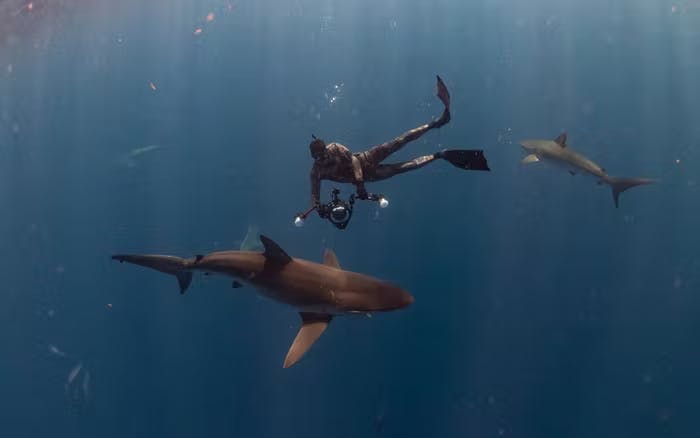
In Fakarava, you have the opportunity to see what is known as a “wall of sharks” without the need for feeding. French Polynesia is actually one of only three places in the world that officially banned shark feeding and/or baiting. Fakarava also features some of the best snorkeling in the world. Most of the diving is less than 60ft, and in some areas, you can freedive 30ft to see the sharks up close. Grey Reef Sharks are the most popular sharks found on this dive, but you can also see large populations of Lemon Sharks, Whitecap Sharks, and Hammerheads.
Fakarava has been classified as a UNESCO Biosphere Reserve and therefore has an extremely rich and diverse aquatic ecosystem. Jacques Cousteau declared Rangiroa as one of the most beautiful waters on Earth. At these sites you can see everything from Grey Reef Sharks, to Napoleon Wrasse, to Manta Rays, to Humpback Whales! This dive really is an amazing tropical paradise and a great way to end our best shark dives list!
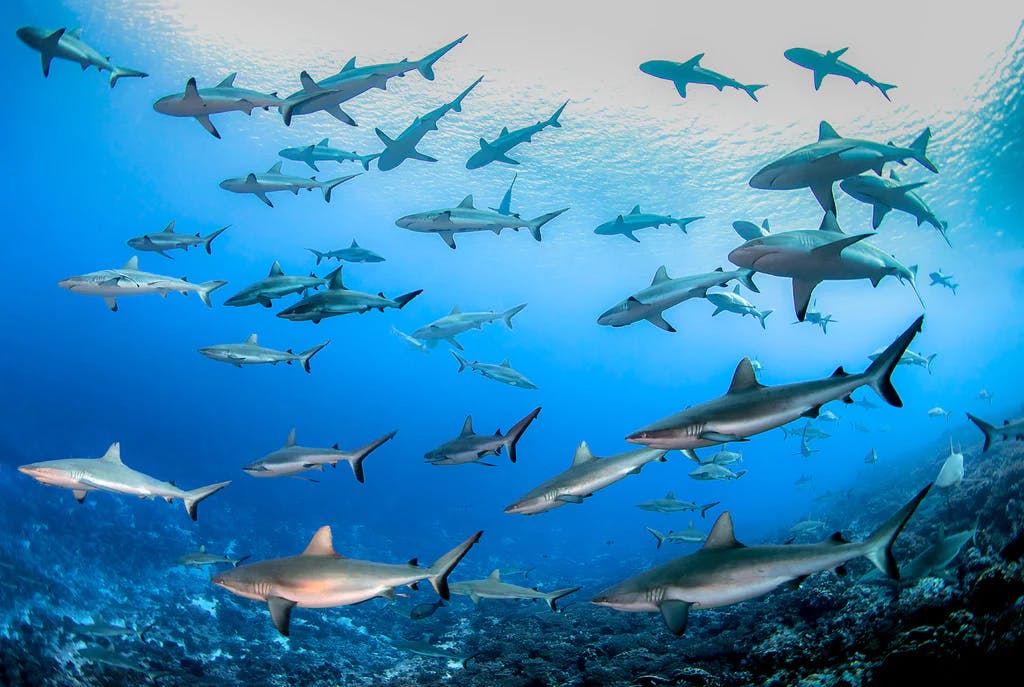
Written by: Steven Fandl
The Whale Shark is the largest fish in the ocean reaching lengths up to 42ft long, but they are absolutely harmless. Whale Sharks are filter feeders, meaning they only eat planktonic organisms and small fish.
Most sharks live on average 20-30 years, however there are some that live much longer. Whale Sharks for example are thought to live over 100 years.
Unfortunately, yes. Studies suggest that in the past 50 years, the worldwide shark population has declined by over 70%. The biggest threats to sharks are overfishing for their fins to make shark fin soup, and accidental catches from long line, or gill net fishing.
Unlike humans, sharks have the ability to regenerate their teeth. Over their lifetime, a shark will lose at least 30,000 teeth, and then another will just take its place. This is why we can find so many shark teeth.
Most sharks are not dangerous to humans. Of the hundreds of species of sharks, only about a dozen have been involved in attacks against humans. Humans are not part of a shark's diet, which is why in many cases a shark attack is just a taste. It is still very important to always be wary of your surroundings, and to take sharks seriously. Even though they don’t want to kill you, they very easily could.
Depending on the type of diving and length of the trip the price can vary from $100 to well over $5,000. You can take a day trip in Jupiter, Florida for $195 or take a 5 day trip to Guadalupe Island, Mexico for $3595.
Overall, no. There are a variety of different dive charters and techniques that they use. Some charters will allow you to snorkel and freedive, while some will utilize surface cages and hookah systems to pump air into your regulator. Here at Divers Direct, you are required to possess a certification to purchase and operate a hookah system. There are many shark charters that will require you to be certified. So make sure to do your research before booking.
Most cage diving charters will provide you with all the gear you need. Some will only require you to bring a mask and snorkel. However, when going on shorter day trips, you will most likely be required to bring all your typical diving gear. Gear up as you normally would for the depth and type of dive you are doing. Just try to avoid wearing anything shiny.